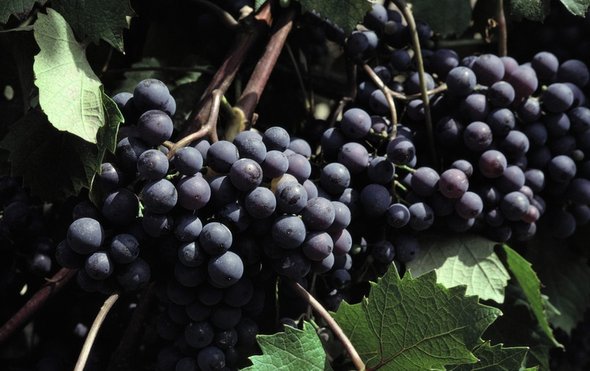(单词翻译:单击)
听力文本
This is Scientific American — 60-Second Science. I'm Christopher Intagliata.
The fires that ripped across Napa and Sonoma last year damaged some two dozen wineries, and burned others completely to the ground.
"Yeah and also don't forget Chile burned pretty good this year too. In fact fires there destroyed quite a few old vineyards." Wes Zandberg, an analytical chemist at the University of British Columbia, at the Okanagan campus, right in B.C.'s wine country. "Basically this is a problem in North and South America this year."
Even wineries that are unscathed by fire may suffer from smoke passing through their vineyards. Because it can leave that year's vintage with unpleasant smoky notes.
Zandberg and his team studied that process with an experimental plot of cabernet franc vines—five of which they exposed to wood smoke, and five they left alone.

They found that when volatile compounds in smoke land on grapes, the fruit very quickly sucks the chemical into its skin or flesh. Then it tags sugar molecules onto the smoky compounds, which renders the smoky substances water soluble, and nontoxic. But that chemical conversion leaves the compounds with no scent or taste..., which means winemakers can't detect them in grapes... until it's too late.
"When you take a bunch of grape juice and expose it to yeast during the fermentation process, the yeast have the required enzymes to cleave that sugar from the smoke-flavored compounds, so it kind of unmasks them during fermentation." Making them once again detectable by nose and tongue.
The findings are in the Journal of Agricultural and Food Chemistry.
The study was funded in part by a local chemical testing company, which hopes to develop a test for various smoky substances in the grapes, to predict whether so-called 'smoke taint' will be a perceptible problem in the finished wine.
Until then, Zandberg has this advice for wildfire-affected winemakers: "One obvious strategy for minimizing smoke taint in wine, is don't put it in a toasted oak barrel. That's just going to put more compounds in there that give that odor, or flavor."
Thanks for listening for Scientific American — 60-Second Science. I'm Christopher Intagliata.
参考译文
这里是科学美国人——60秒科学。我是克里斯托弗·因塔利亚塔。
去年,纳帕和索诺玛发生的火灾摧毁了约20家葡萄酒庄,并将其他酒庄烧为平地。
“对,同样不要忘了智利今年也发生了严重的火灾。实际上,智利的大火烧毁了很多老葡萄园。”加拿大不列颠哥伦比亚大学奥肯那根分校的分析化学家韦斯·赞德伯格说,该分校就位于不列颠哥伦比亚省的葡萄酒乡。“基本上来说,这是今年北美和南美遇到的问题。”
甚至在火灾中未受损的酒庄,也可能因为从酒庄穿越而过的烟雾而受到影响。因为烟雾会令那一年酿的酒带有令人不快的烟熏味。
赞德伯格和团队在品丽珠葡萄藤试验田对这一过程进行了研究,其中五株葡萄藤接触了木材烟雾,另外五株被隔离。
他们发现,当烟雾中的挥发性化合物落在葡萄上时,葡萄很快会将化合物吸入果皮或果肉中。然后葡萄会将糖分子附着在烟熏化合物上,使烟雾状物质可溶于水且无毒。但是这种化学转化使这些化合物变得没有香味或味道,这意味着酿酒师无法在葡萄中发现它们,发现时则为时已晚。
“当你在发酵过程中摄取一束葡萄汁并将其置于酵母中时,酵母能从烟味化合物中切割糖所需的酶,所以会在发酵过程中将它们揭开。”这使它们再次被鼻子和舌头检测到。
该研究发表在《农业与食品化学杂志》上。
这项研究由当地一家化学测试公司赞助,该公司希望开发测试葡萄中的各种烟雾物质,以预测所谓的“烟雾污染”是否会在成品酒中成为可察觉到的问题。
在那之前,赞德伯格为受野火影响的酿酒师提出了如下建议:“最小化葡萄酒中烟味的其中一个明显策略是,不要把它们放在被烘烤过的橡木桶里。这样就能增加产生气味或味道的化合物。”
谢谢大家收听科学美国人——60秒科学。我是克里斯托弗·因塔利亚塔。
译文为可可英语翻译,未经授权请勿转载!
重点讲解
重点讲解:
1. burn to the ground 烧为灰烬;夷为平地;
A complete tenement block was burnt to the ground.
整幢公寓大楼被付之一炬。
2. suffer from 遭遇,遭受,蒙受(不好的事);
Dieters suffer from violent mood swings.
节食者会有激烈的情绪波动。
3. expose to 使暴露于(险境);使遭受(危险或不快);
By bathing in unclean water, they expose themselves to contamination.
在不干净的水中洗澡,他们可能会受到感染。
4. once again 又一次;再次;
Nurtured carefully, the business can once again get back to basics.
只要用心经营,公司可以重回正轨。


